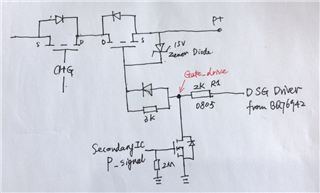Hi Matt, Terry,
When I debug the BMS, I meet a MOSFET driving issue. That is I have secondary protection IC, and if AFE fails, the secondary protection IC will pull down the MOSFET driver pin directly.
The schmatic is shown as the below picture. I use a 2K resistor(R1) to connect bwtween the DSG pin of BQ76942 and the Gate drive point(shown in the picture in red).
If the secondary IC proecction happens, it will pull the point Gate drive to ground via a N-mosfet.
My question is if the Gate drive point is pulled down to the ground, the DSG mosfet driver current will all flow via the R1.
Will this design damage the mosfet driver of BQ76942?

BTW, is the mosfet driver of BQ76942 a voltage source or a current source? If it is a current source, how much is its current value?
If I don't pull down to the ground, but with a resistor between the pull down mosfet and Gate drive, what value should I choose the resistor? Will it turn off the DSG fet completely?
Thank your for your help.


